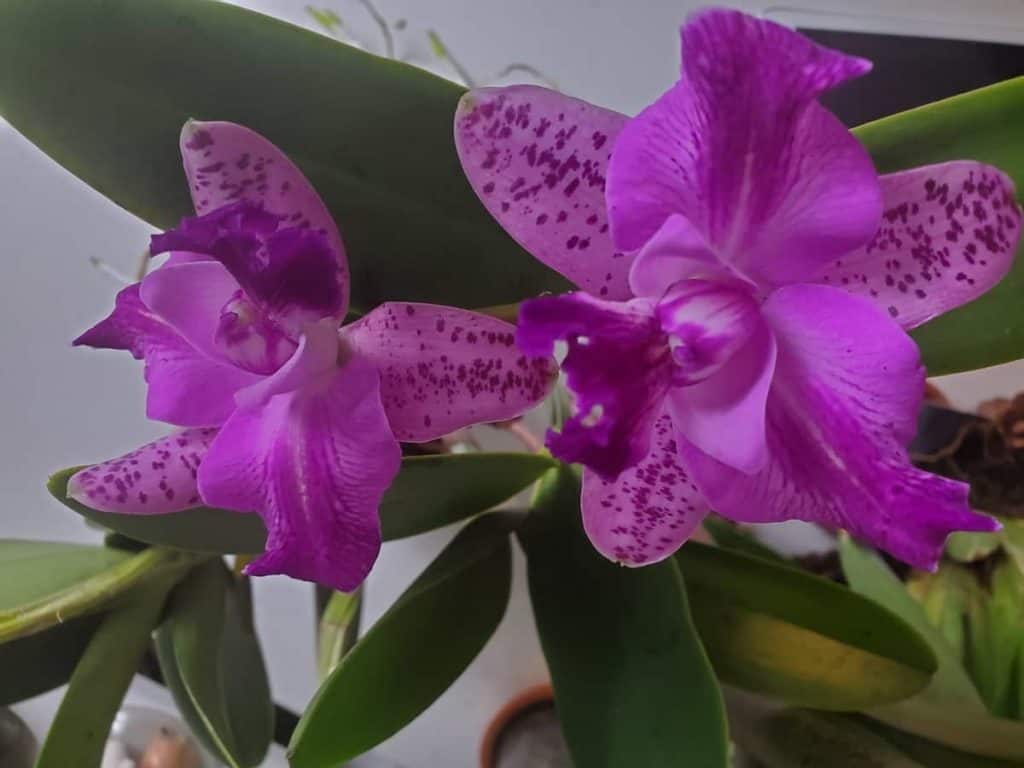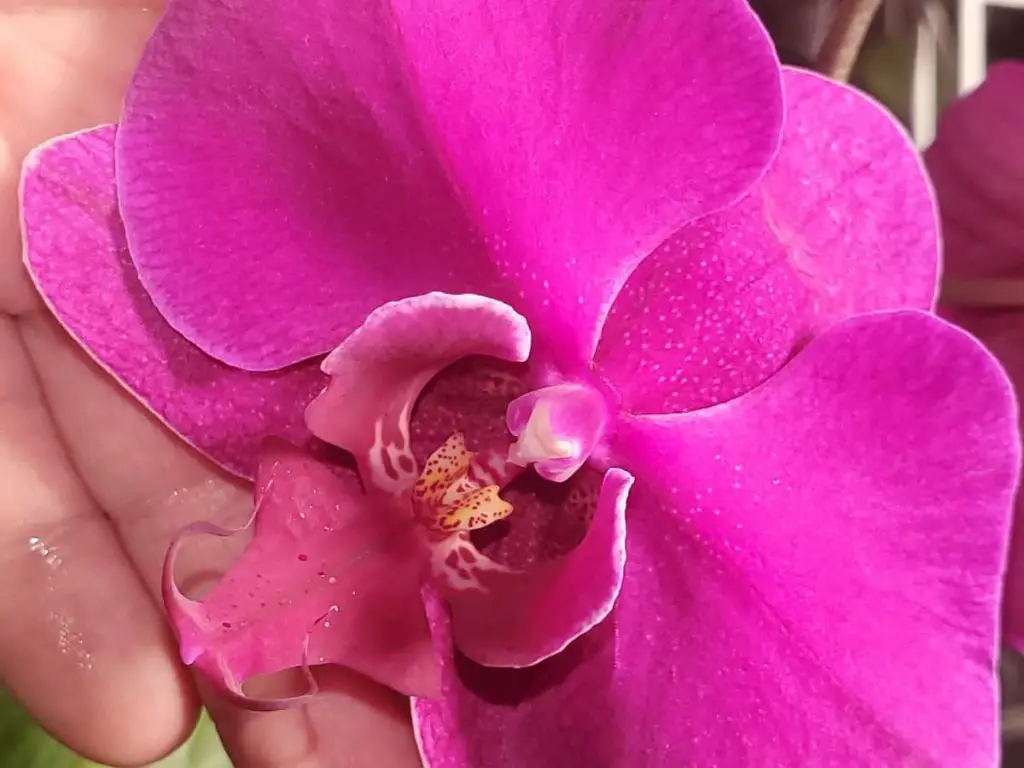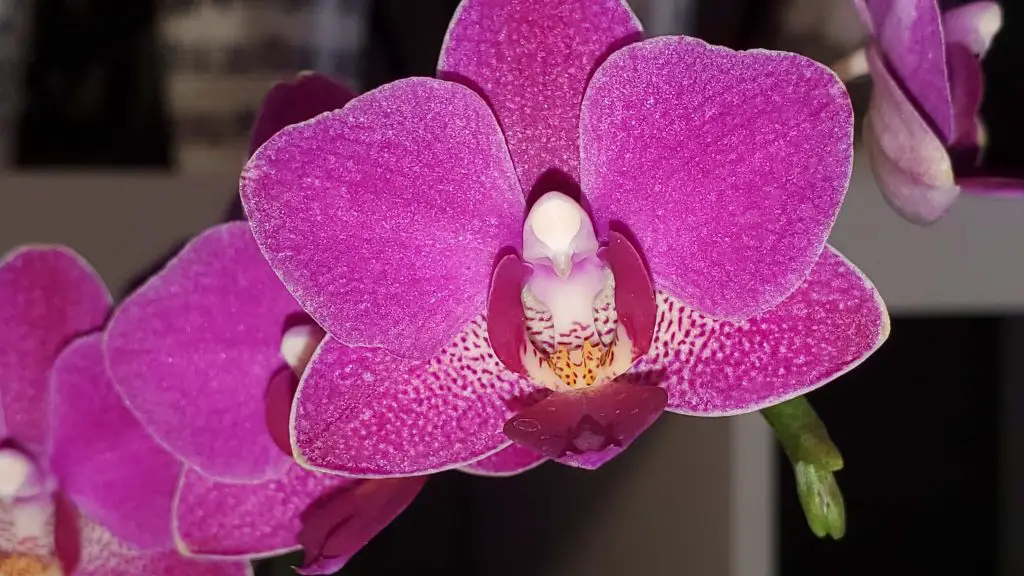In nature, leaves turn colors in autumn, most fall off during winter, and some remain evergreen. This change in leaf color is truly beautiful to watch—expect when it’s with your orchid. When orchid leaves a change color, they are warning you that something is not quite right.
And purple? What could be more alarming than purple orchid leaves?

Some situations aren’t harmful though, and don’t require any additional tweaks.
Other colors, like brown, black, yellow, and white require immediate attention.
Reasons For Purple Spots on Orchid Leaves
- Too much Direct Sunlight
- Overheating
- Nutrient Deficiency
- Inadequate Fertilization
- Dormancy, or Winter Blues
- Cold Temperatures
- Pests & Insects
- Drought Stress
- Varying Species in the Same Genus
The advice below for purple spots on orchid leaves is only valid if you have checked the roots and potting medium. Is there enough ventilation and air circulation inside the pot? If your potting medium breaking down or there is root rot, then the purple leaves are the least of your concerns.
Take a quick look at the health-standard of your roots. If everything seems okay, then proceed to find out what’s causing the purple leaves.
Let’s take a look at 9 possible causes for what purple orchid leaves represent.You’re in luck!
There’s a video about this exact content so you don’t have to read all 3,000 words below. 🙂 https://www.youtube.com/embed/4OioGTtLfOA
Purple Flower, Purple leaf?
You might think that purple spots on the leaves could be related to the color of the flower. If the blossom is a dark, emperor-inspired purple, then the leaves would also recreate speckled tinges of the same ornate color.
Even though it’s true that some darker orchid blossoms have darker flower spikes, this isn’t directly related to darker purplish red spots on its leaves. You can have a pure white Phalaenopsis orchid with maroon-colored spots on its leaves.
What is worthy of noting though is that some Phalaenopsis have darker leaves genetically. You shouldn’t be concerned if the leaves are plump, not withered or deeply veined. If you grow two orchids side by side, and one has purple spots and the other one doesn’t, don’t be worried.
If just means that your specific Phalaenopsis species has darker leaves.

If you only have one orchid, it’s hard to compare in between different colors, discovering what a normal green would be. Dark green is not the normal orchid’s leaf color, even though it’s a beautiful color. The standard is a grassy-green, with yellow undertones.
If the purple spots are here and there, creating a freckled look, then you’re fine.
You can keep the orchid in the spot where it’s at. Just take a close look at the roots to see how they are doing, and keep your orchid well-ventilated.
Unfortunately, many grocery stores and super market tags hardly have the name of the orchid written on them, much less the genus and species. I picked up three mini-Phals from Lowes the other day, and they didn’t even have Phalaenopsis written on them, just the local cultivator.
Tip: If you have the species name, you can research other pictures to get a better idea. There is a good website for this kind of search at the FTD by Design, which is a flower store. It has pictures and an info-graphic for explaining the of orchid origins and families.
which is a flower store. It has pictures and an info-graphic for explaining the of orchid origins and families.
If it’s pictures you’re after, also check out my Pinterest Page. I have thousands of pins of each different type (genus) of orchid, and have tried my best to name them all. It’s good inspiration, too, when you’re feeling down to browse through orchid floral arrangements and orchid terrariums. Anyway, I digress… back to our topic.
I have thousands of pins of each different type (genus) of orchid, and have tried my best to name them all. It’s good inspiration, too, when you’re feeling down to browse through orchid floral arrangements and orchid terrariums. Anyway, I digress… back to our topic.
What causes purple orchid leaves?
Too much direct sunlight
One possible cause is the production of a natural sunscreen, produced by the antioxidant anthocyanins, when the orchid exposed to brighter lights than it’s familiar with.
If you have an orchid that receives sunlight on only one side, but not the other, you’ll quickly notice that the shaded side remains green, but the full-sun side starts to redden lightly. The leaves turn a faint purple, in response to the bright direct sun.
This happens a lot when mounting orchids on trees. On side of the tree gets too much shade, while the other is in direct sunlight. To pick a better spot to mount your orchids on trees,read this article, about mounting tree orchids.
Overheating
Overheating can be another cause of purple spots. Touch the leaf to see how hot it is. It might be getting sufficient light, but the temperature of the light it’s receiving is too hot for it.
When the leaf “cooks” from the outside in, it damages the transportation system that naturally carries water and other nutrients to around the orchid. If the leaves are hot, move the orchid to another location, or at least further away from the window, or use a fan that circulates cool air. Fans also promotes less crown rot.

Temperature Chill
Overheating and destroying the vascular system causes purple leaves, but another cause is cold temperatures. Every orchid has its special temperature that it thrives in. For example, Phalaenopsis during the day prefer 65º F to 75ºF.
At night it can drop to around 60º F.
If it sits on a window sill and the night temperatures drop below that, or receive a cool chill from a constant breeze, the orchid might react turning purple. Be careful that the orchid isn’t exposed to these cooler temperatures for long periods of time, because it can cause bud blast and flower blast.
Winter Blues
Yes, it’s true… Orchids get the blues, too. This might seem crazy, but it makes sense once you think about it. In the fall, leaves turn an amazing array of colors: red, yellow, orange, brown—all displaying the top ten places on my soon-to-take-road-trip. (I keep saying that, but I really will go one day.)
In winter—better yet, during dormancy—the leaves of some orchids might darken a bit and turn purple. This is because they are producing less chlorophyll to photosynthesize. They don’t need the extra “metabolism enhancers” since they’re resting. This should be right after the blossom wither and fall off.
If you want to read more about orchid dormancy, this article explains the entire process in more detail. The green fades and the reddish orange colors appear in its place. This is perfectly normal and the color will come back when new roots start to form. Not a sign to be worried.
Loss of Roots
If an orchid loses its roots, it won’t turn purple, but it will start to shade into a sick yellowish-red. This can be confused easily with purple undertones.
The main cause is over watering, causing poor air circulation, and root rot. The pH is then altered and the roots suffer. When one part of the orchid is struggling, it will shut off the production of all other parts—not blooming is the first one. In the case of losing its roots, the leaf will produce less green chlorophyll, turning red.
Insufficient light
But wasn’t the first cause too much light? Yes, it was. But hear me out… The first example was a low-light orchid receiving too much direct sunlight. This example is a high-light orchid that is placed in a darker place, which is not bright. This phenomenon is mostly related to darkening of the leaves, too. The purple spots start at the end of the leaf coincidentally with the darkening of the entire leaf.

Phalaenopsis are very prone to purpling leaves because they are low-light orchids. This doesn’t mean that they live in total darkness, hidden on the lowest shelf of the dark bookcase.
Low-light orchids need a bright space, but never direct sunlight. When the purple starts to spread into a giant marking, the dots growing to bleed together into one big splotch of dark purple, then your orchid is definitely struggling. This deep purple can spread to the crown and pseudobulbs.
Move your orchid to a spot that still receives brighter light, but not as much direct light as it was receiving before. Add a curtain, tune down the grown lights, but change the lighting.
Inadequate Fertilization
Purple orchid leaves could be a problem not only of lighting, but of fertilization. The orchid has enough bright light, but because of the purple spots, but isn’t photosynthesizing the way it should, so its energy levels are low. Upgrade the fertilizer a tiny notch. Tiny as in extremely tiny.
Drought stress
This is a cause of a reddening of the leaves, not necessarily a purple color. When you repot an orchid and have to cut off a significant amount of dead or decaying roots, the plant can suffer until it is better adjusted.
The freshly cut roots will not absorb the same amount of water as a healthy root, and the orchid can suffer form lack of water. With not enough water, the leaves slowly turn a red color, easily confused with purple.
Don’t Stop Learning!
If you want to be included in more information and get a 14-page fertilization guide, please sign up for my newsletter. I don’t spam, but send emails out bi-monthly with some curious topics of interest. If you want more information, click here to go to a specific page on this website where I explain it more in detail.

Also, if you are looking for an orchid journal to keep your notes specifically about orchid care, check out my 2 solutions for that on this page. If note-keeping isn’t your thing, then there is a free excel spreadsheet that you can download. Click here for more information on how to do that.
If you subscribe to my newsletter, I will send you a 14-page guide on the main tips of orchid fertilizer. It is downloadable and you can print it out on your computer. I designed the guide to double up as a coloring book, just to make it fun.
I moved my orchid. How do I know this second place is better?
The opposite of purple leaves is dark green leaves. This dark, luscious, full-green color, which looks like a healthy plant is, in fact, not healthy. This rich avocado color means the leaf is producing extra amounts of chlorophyll to capture the suns rays, specifically because it’s not getting enough energy form the insufficient sunlight. If you moved your orchid to a less direct-sunlight location, then this is a bit too much. Move it back closer toward the initial location, until you find the perfect place for orchids.
Your orchid needs more light. It’s struggling to keep alive, and to get more light, it will use the energy it has to produce more chlorophyll than to bloom.With these tips you should be able to identify what is causing your orchid to have purple leaves. If you had an orchid that turned purple, tell us in the comments below, mentioning how you treated it.
If you don’t think the information in this article really addressed your problem, a suggestion would be to glimpse through these articles: yellowing orchid leaves, black spots on orchid leaves, black rot, and black spots on orchid leaves. These are the most common problems and each article dives into more detailed advice than this overview did, since they tackle each problem directly.
Happy Cultivating!


Hi, I think my orchid is a Phal but I bought it as a small, unpotted sprig at Lowes. It has lasted 2 years and has grown but never bloomed. It sits by my koi pond but I have now brought it in because of cold weather. Proud I’ve kept it alive but sad no bloom. Help. Thanks Nancy Thomas
Hi Nancy,
Thanks for your comment. I really can’t help much without knowing what kind of orchid you have. I worte an article about reblooming Dendrobiums, which some of the inofrmation you can try and test for the Phal. That article is here: https://orchideria.com/how-to-rebloom-a-dendrobium-orchid/
The main reasons for Phals not reblooming usually are no drop at night in temperature ranges, not enough light, or not enough fertilizer. I wish I could help you more, but without exactly knowing what kind it is, it’s hard. But if it is a Phal, try bringing the temperature down for 11F (10C) at night for a month. Sometimes that will induce a new flower spike. As for fertilizer, focus on the high Phosporous or Phosphate in the formula, which is the second number on the bottle (the P in the NPK ratio). With those small changes, it might just start a spike.
If you have had it for 2 years it might be that the potting media is decomposing, too. Have you repotted it during that time? If not, I’d start there, then do the other things mentioned.
-Amanda
“Inadequate Fertilization
Purple orchid leaves could be a problem not only of lighting, but of fertilization. The orchid has enough bright light, but because of the purple spots, but isn’t photosynthesizing the way it should, so its energy levels are low. Upgrade the fertilizer a tiny notch. Tiny as in extremely tiny.”
…………
I FOUND THIS!!!
Now I know my problem with the reddish/purplish leaves on my dendrobiums … so – I will up the fertilisation a notch and see what happens. I did dunk the orchids in tea, and I noticed that the purple is almost gone!! There are tiny veins of purple – but the leaves are now a dark green!! The keiki leaves are still purple, but with bright green stems on the green stalk!! AMAZING!! I will do the “tea dunk” two more times (2 Wednesdays again) to see what happens.
Hi Lyn!
Thank you for your comment! Please keep me updated. 🙂
-Amanda
Hi,
I’m looking for a solution to get rid of mealy bug in my orchids.
It keeps on eating the freshly new leaf and also destroying the flowers. I tried 70% alcohol, dish soap, been oil and store bought spray, unfortunately nothing solves my problem.
Please help.
Thank you,
Paz